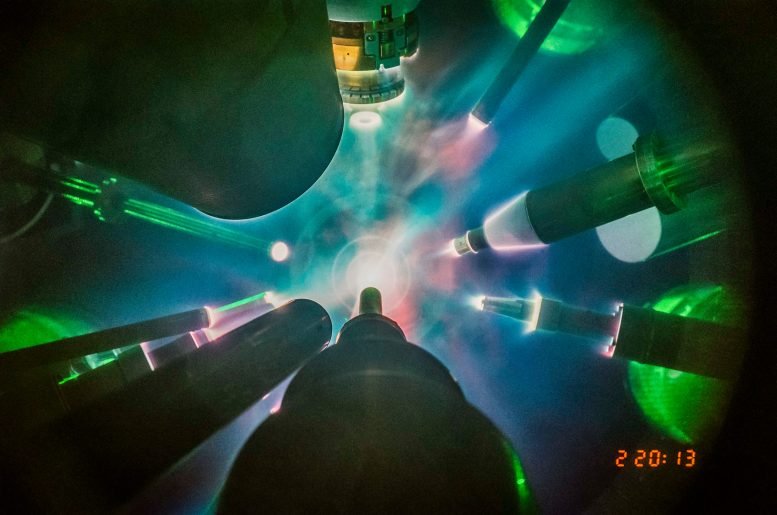
A a view from inside the OMEGA target chamber during a direct-drive inertial fusion experiment at the University of Rochester’s Laboratory for Laser Energetics. Scientists fired 28 kilojoules of laser energy at small capsules filled with deuterium and tritium fuel, causing the capsules to implode and produce a plasma hot enough to initiate fusion reactions between the fuel nuclei. The temperatures achieved at the heart of these implosions are as high as 100 million degrees Celsius (180 million degrees Fahrenheit). The speed at which the implosion takes place is typically between 500 and 600 kilometers per second (1.1 to 1.35 million miles per hour). The pressures at the core are up to 80 billion times greater than atmospheric pressure. Credit: University of Rochester Laboratory for Laser Energetics photo / Eugene Kowaluk
Methods pioneered using the Laboratory for Laser Energetics’ OMEGA laser system show potential for sparking fusion on a larger scale.
Researchers at the University of Rochester’s Laboratory for Laser Energetics (LLE) have led experiments showcasing an efficient “spark plug” for direct-drive approaches to inertial confinement fusion (ICF). In a pair of studies featured in Nature Physics, the team shares their findings and details the potential for scaling up these methods, aiming for successful fusion in a future facility.
LLE is the largest university-based U.S. Department of Energy program and hosts the OMEGA laser system, which is the largest academic laser in the world but still almost one hundredth the energy of the National Ignition Facility (NIF) at the Lawrence Livermore National Laboratory in California. With OMEGA, Rochester scientists completed several successful attempts to fire 28 kilojoules of laser energy at small capsules filled with deuterium and tritium fuel, causing the capsules to implode and produce a plasma hot enough to initiate fusion reactions between the fuel nuclei. The experiments caused fusion reactions that produced more energy than the amount of energy in the central hot plasma.
The OMEGA experiments use direct laser illumination of the capsule and differ from the indirect drive approach used on the NIF. When using the indirect drive approach, the laser light is converted into X-rays that in turn drive the capsule implosion. The NIF used indirect drive to irradiate a capsule with X-rays using about 2,000 kilojoules of laser energy. This led to a 2022 breakthrough at NIF in achieving fusion ignition—a fusion reaction that creates a net gain of energy from the target.
Achievements and Future Prospects
“Generating more fusion energy than the internal energy content of where the fusion takes place is an important threshold,” says lead author of the first paper Connor Williams ’23 Ph.D. (physics and astronomy), now a staff scientist at Sandia National Labs in radiation and ICF target design. “That’s a necessary requirement for anything you want to accomplish later on, such as burning plasmas or achieving ignition.”
By showing they can achieve this level of implosion performance with just 28 kilojoules of laser energy, the Rochester team is excited by the prospect of applying direct-drive methods to lasers with more energy. Demonstrating a spark plug is an important step, however, OMEGA is too small to compress enough fuel to get to ignition.
“If you can eventually create the spark plug and compress fuel, direct drive has a lot of characteristics that are favorable for fusion energy compared to indirect-drive,” says Varchas Gopalaswamy ’21 Ph.D. (mechanical engineering), the LLE scientist who led the second study that explores the implications of using the direct-drive approach on megajoule-class lasers, similar to the size of the NIF. “After scaling the OMEGA results to a few megajoules of laser energies, the fusion reactions are predicted to become self-sustaining, a condition called ‘burning plasmas.’”
Gopalaswamy says that direct-drive ICF is a promising approach for achieving thermonuclear ignition and net energy in laser fusion.
Technological Innovations and Collaborations
“A major factor contributing to the success of these recent experiments is the development of a novel implosion design method based on statistical predictions and validated by machine learning algorithms,” says Riccardo Betti, LLE’s chief scientist and the Robert L. McCrory Professor in the Department of Mechanical Engineering and in the Department of Physics and Astronomy. “These predictive models allow us to narrow the pool of promising candidate designs before carrying out valuable experiments.”
References:
“Demonstration of hot-spot fuel gain exceeding unity in direct-drive inertial confinement fusion implosions” by C. A. Williams, R. Betti, V. Gopalaswamy, J. P. Knauer, C. J. Forrest, A. Lees, R. Ejaz, P. S. Farmakis, D. Cao, P. B. Radha, K. S. Anderson, S. P. Regan, V. Yu Glebov, R. C. Shah, C. Stoeckl, S. Ivancic, K. Churnetski, R. T. Janezic, C. Fella, M. J. Rosenberg, M. J. Bonino, D. R. Harding, W. T. Shmayda, J. Carroll-Nellenback, S. X. Hu, R. Epstein, T. J. B. Collins, C. A. Thomas, I. V. Igumenshchev, V. N. Goncharov, W. Theobald, K. M. Woo, J. A. Marozas, K. A. Bauer, S. Sampat, L. J. Waxer, D. Turnbull, P. V. Heuer, H. McClow, L. Ceurvorst, W. Scullin, D. H. Edgell, M. Koch, D. Bredesen, M. Gatu Johnson, J. A. Frenje, R. D. Petrasso, C. Shuldberg, M. Farrell, J. Murray, D. Guzman, B. Serrato, S. F. B. Morse, M. Labuzeta, C. Deeney and E. M. Campbell, 5 February 2024, Nature Physics.
DOI: 10.1038/s41567-023-02363-2
“Demonstration of a hydrodynamically equivalent burning plasma in direct-drive inertial confinement fusion” by V. Gopalaswamy, C. A. Williams, R. Betti, D. Patel, J. P. Knauer, A. Lees, D. Cao, E. M. Campbell, P. Farmakis, R. Ejaz, K. S. Anderson, R. Epstein, J. Carroll-Nellenbeck, I. V. Igumenshchev, J. A. Marozas, P. B. Radha, A. A. Solodov, C. A. Thomas, K. M. Woo, T. J. B. Collins, S. X. Hu, W. Scullin, D. Turnbull, V. N. Goncharov, K. Churnetski, C. J. Forrest, V. Yu. Glebov, P. V. Heuer, H. McClow, R. C. Shah, C. Stoeckl, W. Theobald, D. H. Edgell, S. Ivancic, M. J. Rosenberg, S. P. Regan, D. Bredesen, C. Fella, M. Koch, R. T. Janezic, M. J. Bonino, D. R. Harding, K. A. Bauer, S. Sampat, L. J. Waxer, M. Labuzeta, S. F. B. Morse, M. Gatu-Johnson, R. D. Petrasso, J. A. Frenje, J. Murray, B. Serrato, D. Guzman, C. Shuldberg, M. Farrell and C. Deeney, 5 February 2024, Nature Physics.
DOI: 10.1038/s41567-023-02361-4
The Rochester experiments required a highly coordinated effort between a large number of scientists, engineers, and technical staff to operate the complex laser facility. They collaborated with researchers from the MIT Plasma Science and Fusion Center and General Atomics to conduct the experiments. These experiments were funded through the US Department of Energy’s National Nuclear Security Administration. The target design work resulted from machine-learning applications funded by the DOE Fusion Energy Sciences program.

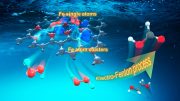



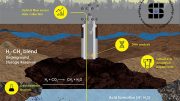
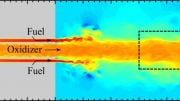
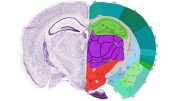

Scientific research guided by correct theories can help humanity avoid detours and failures.
Please answer:
1. What is the direction of future energy for human society?
2. Which is more important for humanity in terms of energy generation and utilization?
3. Is the energy generated by nature insufficient for human utilization?
4. Are mathematics and mathematical models unscientific?
5. Can science imagine without considering mathematical laws?
6. Are so-called academic journals (such as Physical Review Letters, Nature, Science, etc.) scientific and honest?
and so on.
Today, we have already entered the era of the internet. With the help of artificial intelligence and big data, discussions on scientific knowledge have become open and transparent. However, a group of editors of so-called academic journals (such as Physical Review Letters, Nature, Science, etc.) are mystifying themselves. They only care about their own so-called sufficiently high priority rating, general significance, discipline, novelty, etc., and do not care about what science and pseudoscience are.
Science and pseudoscience are not determined by a publication, an organization or a person, nor by you or me, but by mathematics the final say. Physical models must be based on mathematics or mathematical models in order to be scientific, convincing, and in accordance with natural laws.
The branch of mathematics known as topology has become a cornerstone of modern physics. The perpetually swirling topological vortices defy traditional physics’ expectations. A physical properties of topological vortices is their to spontaneously begin to change periodically in time, even though the system does not experience corresponding periodic interference. Therefore, in the interaction of topological vortices, time is both absolute and relative,and physics often requires treating space and time at the same level.
Low-dimensional spacetime matter is the foundation of high-dimensional spacetime matter. Low-dimensional spacetime matter (such as topological vortex) can form new material structures and derive more complex physical properties via interactions and self-organization. It is extremely wrong and irresponsible to imagine low dimensional spacetime matter using high-dimensional spacetime matter.
Science must follow mathematical rules. For example, the Standard Model (SM) is considered to be one of the most significant achievements of physics in the 20th century. However, the magnetic moment of μ particle is larger than expected, revealed by a g-2 experiment at Fermilab, suggests that the established theory (such as SM) of fundamental particles is incomplete. Furthermore, the SM omitting gravitation, it not involved the time problem and when the particle movement starts. Mathematics is the foundation of science. Physics must respect the scientific nature of mathematics and mathematical models. The SM must be based on mathematical models in order to be scientific, convincing, and in line with natural laws.
I hope researchers are not fooled by the pseudoscientific theories of the Physical Review Letters (PRL), and hope more people dare to stand up and fight against rampant pseudoscience.
The so-called academic journals (such as Physical Review Letters, Nature, Science, etc.) firmly believe that two high-dimensional spacetime objects (such as two sets of cobalt-60) rotating in opposite directions can be transformed into two objects that mirror each other, is a typical case of pseudoscience rampant.
If researchers are really interested in Science and Physics, you can browse https://zhuanlan.zhihu.com/p/643404671 and https://zhuanlan.zhihu.com/p/595280873.
This Interttial Confinement Fusion work is absolute nonsense. No realistic means of procing energy commercially is even imaginable using this work.
The SM is overly complex due to a wide-spread misapprehension of the usefulness of the maths. Mathematical formulations are highly regarded, rightfully, however it is generally forgotten that the maths are very plastic, several self-consistent sets of equations may be contrived to explain the same phenomenon, Lakeoff and Nunez rightly point out that all maths are mapping functions – maps pare not necessarily reality. The universe does not do math, the universe IS geometry, therefore mathematics is at a twice remove from reality.
Very good! The universe does not do math (formula), the universe IS geometry.
The branch of geometry (mathematics) known as topology has become a cornerstone of modern physics. Topological vortex and antivortex are two bidirectional coupled continuous chaotic systems. They exhibit parity conservation, charge conjugation, and time reversal symmetry. The synchronization effect is extremely important in their interactions. The synchronization effect of the superposition, deflection, and twisting of multiple or countless topological vortices will make spacetime motion more complex.
If you are interested, you can browse https://zhuanlan.zhihu.com/p/463666584 and https://zhuanlan.zhihu.com/p/390071860.